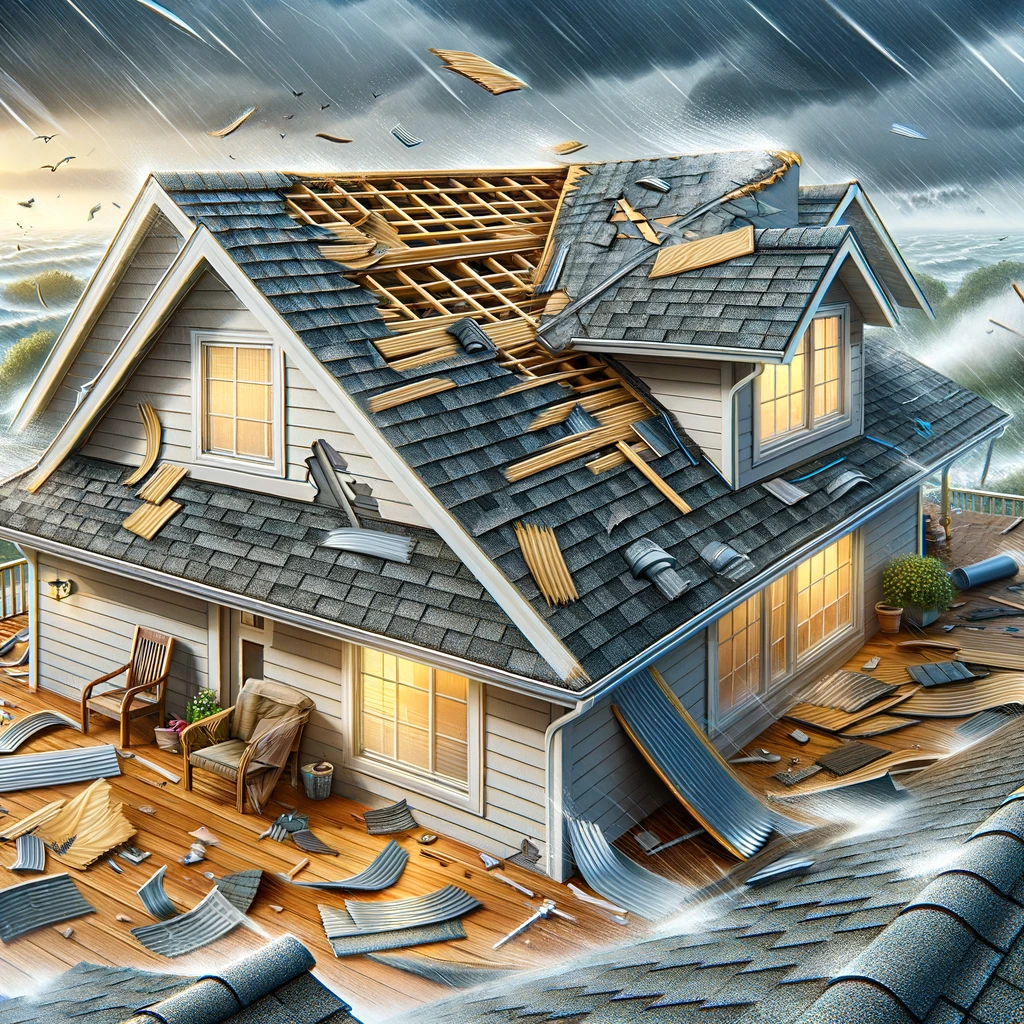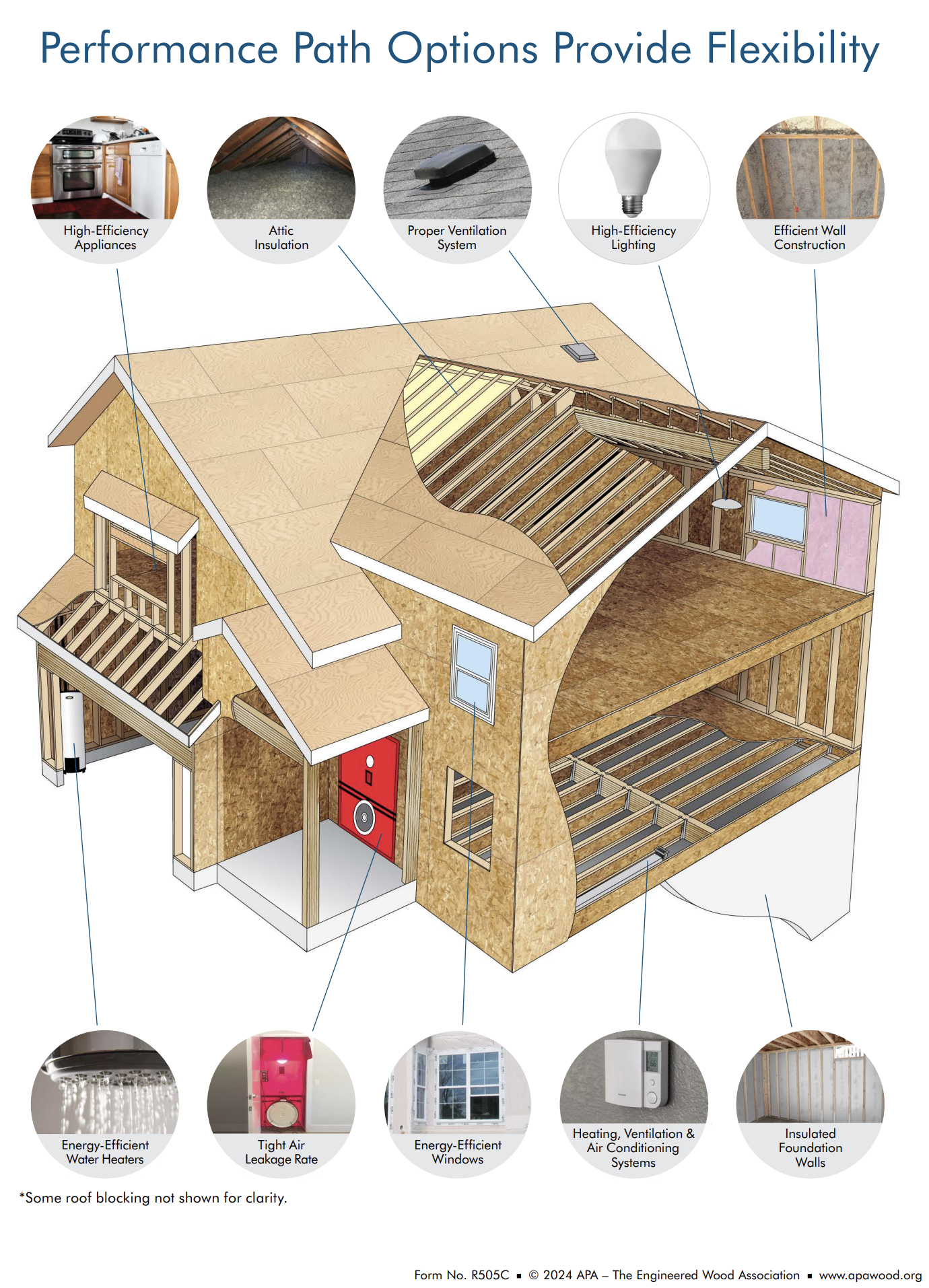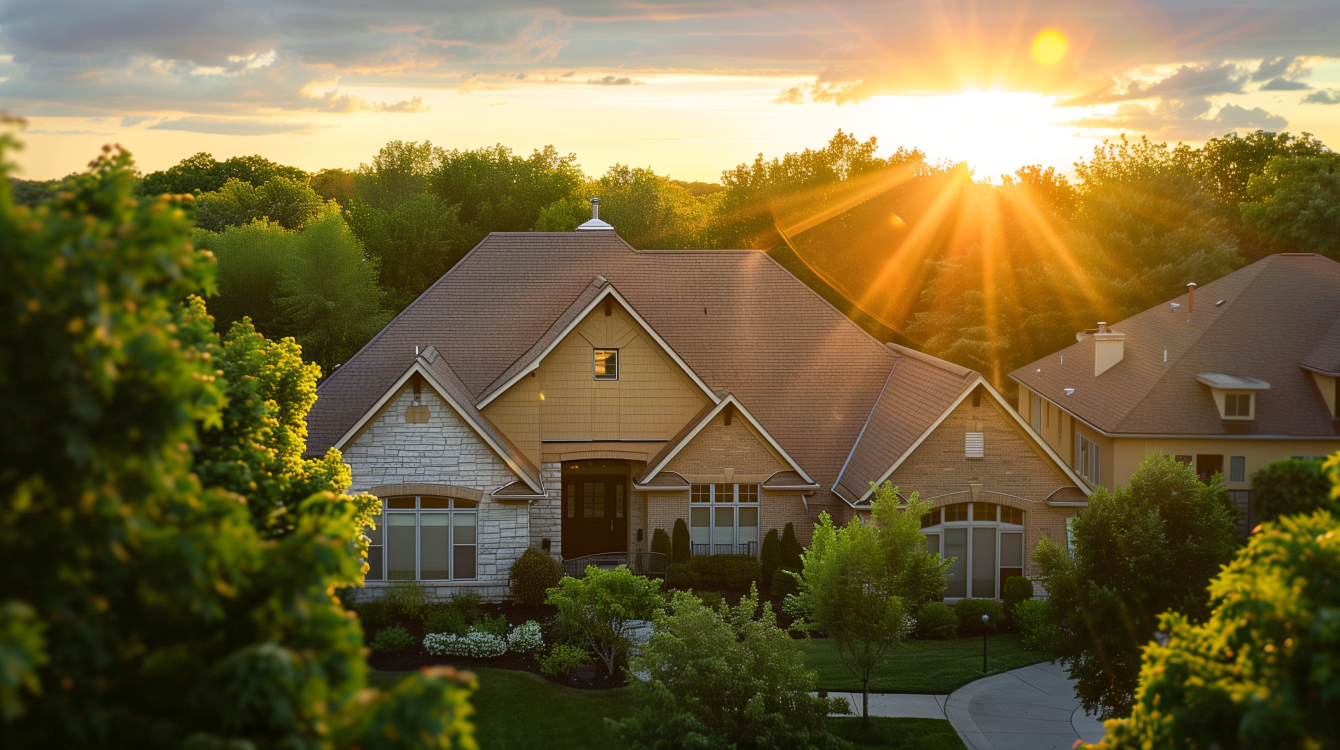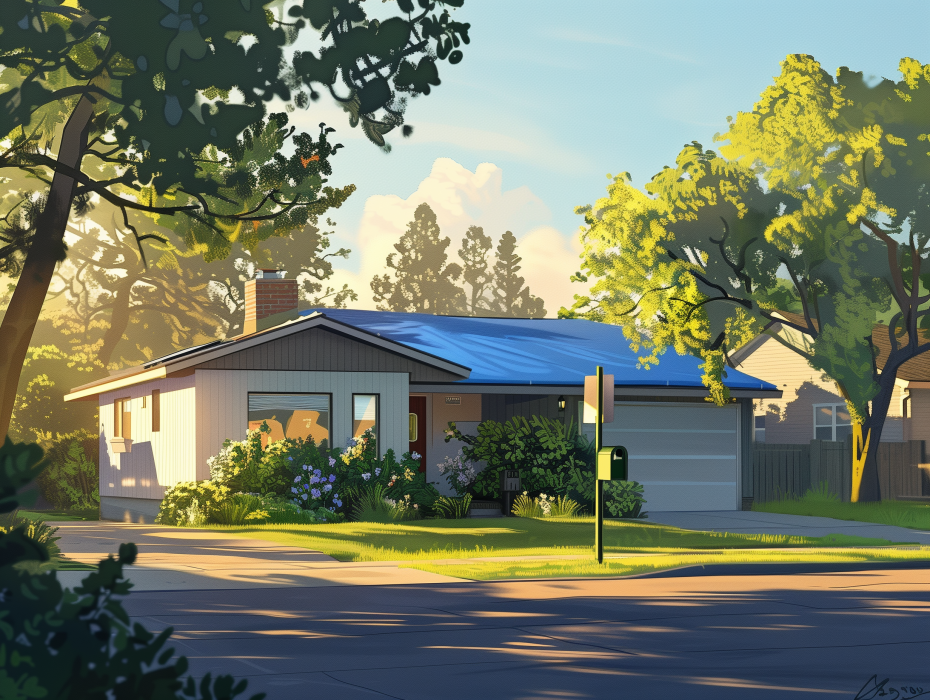Introduction: In the wake of high wind events, asphalt roof shingles can sustain damage that isn’t always immediately apparent. This blog post outlines key procedures and standards for accurately assessing wind damage to asphalt roof shingles, ensuring effective restoration and insurance claim accuracy.
Key Points:
- Material Composition and Impact on Wind Resistance:
- Asphalt shingles are primarily made of a reinforcing mat (fiberglass or organic), asphalt coatings, and a layer of mineral granules.
- The mineral granules protect against UV rays and weathering, while the material composition influences the shingle’s wind resistance.
- Installation and Grade:
- Proper installation following National Roofing Contractors Association (NRCA) guidelines is crucial.
- Higher-grade shingles have greater asphalt content and higher wind ratings, improving durability and wind resistance.
- Standardized Wind Testing and Building Code Requirements:
- Asphalt shingles are tested according to ASTM D3161 for wind resistance, classifying them into three classes (A, D, F) based on velocity withstand.
- Building codes (IBC and IRC) require shingles to meet certain wind resistance criteria, often referencing ASCE 7 for design loads.
- Typical Wind Damage Identification:
- Common wind damage includes un-adhered or missing shingles, bent or failed shingles, and punctured or scuffed shingles.
- Damage identification involves a practical, non-destructive method including on-site visual and physical evaluation.
- Repair and Replacement Recommendations:
- The extent of damage (minimal, moderate, severe) determines the repair approach.
- Options range from replacing individual shingles to full roof replacement, based on overall roof condition and damage extent.
- Legal and Industry Standards Compliance:
- Compliance with local regulations and industry standards, like IRC, IBC, ASTM, and NRCA guidelines, is vital for ensuring quality and durability.
Shingle Distress From Wind
- Partially or Fully Un-Adhered Shingles:
- These shingles or shingle tabs can be easily lifted by hand and may show varying degrees of surface distress.
- Un-adherence can result from wind uplift, manufacturing or installation defects, natural weathering, or improper storage prior to installation.
- Depending on the extent of un-adherence, these shingles or tabs can either be repaired or replaced.
- Bent/Failed Shingles:
- These show flexural distress usually parallel to the edge of the exposed shingle or tab.
- Often, the shingle or tab is partially or completely detached from the underlying shingle due to wind uplift and lateral loads.
- A crease in the shingle indicates flexural distress, necessitating shingle replacement.
- Missing Shingles:
- This condition, with exposed underlayment or roof decking, typically results from high wind distress or improper installation.
- Areas like ridges and corners, which face higher wind pressure, are more prone to this type of distress.
- Replacement of missing shingles is mandatory.
- Punctured, Scuffed Shingles:
- Wind-borne debris can lead to scuff marks or punctures on shingles.
- A scuff mark may remove granules from the shingle surface, reducing UV protection and potentially requiring repair or replacement based on the severity.
Shingle Group Distress Categories:
- Group I: Includes Bent, Missing, and Punctured shingles.
- Group II: Divided into Partially un-adhered and Fully un-adhered shingles.
- Quantification for Group I Distress:
- For 3-tab shingles, any distress is counted once per shingle, regardless of the number of tabs affected. This is because the damage to any one tab necessitates replacing the entire shingle.
- The formula to calculate the percentage of damaged shingles on a square of shingles with Group I distress is: (Ns/80)×100(Ns/80)×100 (Eq. 1), where NsNs is the number of damaged shingles observed in a 10′ x 10′ sample area.
- Quantification for Group II Distress:
- For laminated shingles, a partial un-adhered shingle is one where one-third or less of the shingle is un-adhered. More than this is considered fully un-adhered.
- For 3-tab shingles, individual tabs are assessed. Partial un-adhered tabs are those where corners can be lifted; fully un-adhered tabs are those where the entire tab can be lifted.
- The calculation for damaged shingles with Group II distress uses Eq. 1 for laminated shingles and Eq. 2 for 3-tab shingles. Equation 2 is: (Nt/240)×100(Nt/240)×100, where Nt represents the number of damaged shingle tabs in the sample area.
Damage Assessment and Recommendations
- The damage assessment categorizes roof shingle distress as minimal, moderate, or severe, based on the type and percentage of distress.
- Factors considered in the assessment include the overall condition of the roof, type, degree, and extent of distress, installation quality, and the age of the roof.
- Repair versus replacement decisions may also involve other factors like shingle availability and local code requirements.
- Minimal Damage:
- Group I Distress: Typically less than 2%.
- Group II Distress: Up to 7%.
- Recommendation: Replace individually bent, punctured, or missing shingles. Hand seal partially un-adhered shingles as per the shingle manufacturer’s recommendations.
- Moderate Damage:
- Group I Distress: Typically below 15%.
- Group IIB Distress: Ranges from 8% to 15%.
- Total Group II Distress (IIA + IIB): Should not exceed 25%.
- Recommendation: Decisions depend on factors like the age of the shingles. Newer shingles lying mostly flat can be hand-sealed, while older shingles may require full replacement.
- Severe Damage:
- Group I and IIB Distress: Moderate to high (above 15%).
- Total Group II Distress (IIA + IIB): More than 25% is categorized as severe.
- Recommendation: Replacement of the entire roof is advised as it is economically unfeasible to repair more than 25% of the roof area.
PRACTICAL WIND DAMAGE ASSESSMENT PROCEDURE
- Evaluating Wind Speeds: It’s crucial to assess the wind speeds that the structure experienced. Site-specific weather information can be sourced from organizations like NOAA.
- Roof Examination: The assessment involves a thorough inspection of the roof, drawing a roof plan, and noting any damage not related to wind.
- Sampled Areas for Analysis: A 10′ x 10′ area (or “one square” of roofing) is used for a representative sample. The number of sample areas depends on the total roof area.
- Types of Distress Analysis: The roof is checked for various types of distress, including un-adhered, bent, missing, punctured, or scuffed shingles. The assessment includes visual observations and physical checking by lifting the bottom edge of each shingle.
- Categorization of Damage: The distress is categorized into groups for replacement or repair decisions. Group I includes bent, missing, and punctured/scuffed shingles which require replacement. Group II includes partially and fully un-adhered shingles that may need repair or replacement.
- Damage Assessment and Recommendations: The overall damage is categorized as minimal, moderate, or severe based on the type and percentage of distress. Repair or replacement decisions are made based on the severity of damage, overall roof condition, and other factors such as shingle availability and local codes.
REPAIR PROCEDURE FOR UN-ADHERED ASPHALT SHINGLES
- Identification of Un-Adhered Shingles: Shingles that are partially or fully un-adhered can usually be lifted by hand, indicating a need for repair or replacement.
- Re-Sealing Un-Adhered Shingles: The likelihood of a shingle re-sealing itself is low, especially if it has been exposed to high temperatures, previous wind events, or contamination.
- Hand Sealing as a Repair Method: Hand sealing is a recommended repair for partially and fully un-adhered shingles. It involves placing adhesive under the shingle using a caulking gun or small trowel. However, hand sealing does not restore the shingle to its original wind resistance.
- Manufacturer’s Recommendations: Most shingle manufacturers allow hand sealing under certain conditions. The quality of repair depends on several factors, including the age of the shingle and the conditions leading to un-adherence.
Building Code and Shingle Specification
- The building code wind requirements for residential asphalt shingles are not precisely defined, leading to potential specification of underperforming shingles in certain regions.
- It’s recommended to use ASTM D3161 Class D shingles in wind zone regions of 100 mph (3-second) or less and Class F shingles in regions of 110 mph (3-second) or more.
- Manufacturer’s Wind Rating:
- It’s important to install shingles with a wind capacity matching or exceeding the design wind speeds for the roof structure.
- Standard grade 3-tab shingles typically have a manufacturer wind rating of 60 mph, with higher-grade versions rated up to 80 mph.
- Standard grade laminated shingles have wind ratings between 70 and 80 mph, while high-grade laminated shingles can go up to 110 mph.
- These ratings are based on ASTM test procedures and don’t directly correlate to basic design wind speeds as outlined in the International Residential Code (IRC).
- Standardized Asphalt Shingle Wind Testing:
- The International Building Code (IBC) requires that asphalt shingles be tested in accordance with ASTM D3161, which classifies shingles into three classes based on wind velocity: Class A (60 mph), Class D (90 mph), and Class F (110 mph).
- The ASTM D3161 test results don’t correlate directly to wind speeds experienced in service nor to the 3-second basic design wind speeds.
- Shingle Wind Rating and Building Code Requirements:
- The IBC and IRC provide wind resistance code requirements for roofing assemblies and roof coverings, but some requirements are not well defined, leading to the use of underperforming shingles in certain areas.
- The IRC states that shingles meeting ASTM D3161 are acceptable for use in wind zones less than 110 mph (3-second), but doesn’t specify a shingle classification.
- The code requires Class F shingles for areas with basic wind speeds of 110 mph or higher and where special fastening is required.
Repair vs. Replacement Decisions
- Recommendations for repairing or replacing a damaged roof consider the material properties, type, and extent of distress.
- The final decision on repair versus replacement may be influenced by factors beyond engineering judgment, such as the availability of similar quality shingles and local code requirements
Conclusion: Understanding and applying these standards and procedures in assessing wind damage to asphalt roof shingles is crucial for accurate damage evaluation and effective restoration. Allied Emergency Services, INC remains committed to providing expert services in line with these guidelines, ensuring the highest quality and satisfaction in storm damage restoration.
For more personalized guidance, consult with engineers and local building codes specific to your location. For immediate service or consultation, you may contact us at Allied Emergency Services, INC.
Contact Information:
- Phone: 1-800-792-0212
- Email: Info@AlliedEmergencyServices.com
- Location: Serving Illinois, Wisconsin, and Indiana with a focus on the greater Chicago area.
If you require immediate assistance or have specific questions, our human support is readily available to help you.
Disclaimer: The information in this blog is based on NEMA standards, which are subject to updates. Always consult the latest guidelines and seek professional advice for specific situations.










